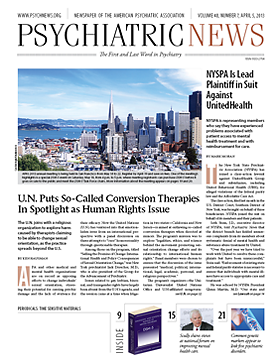Refinements to oppositional defiant disorder (ODD), conduct disorder, and intermittent explosive disorder mark the prominent changes clinicians will see in a new chapter in DSM-5 on “Disruptive, Impulse-Control, and Conduct Disorders.”
The chapter brings together disorders marked by problems with emotional and behavioral self-control that were previously included in the chapter in DSM-IV titled “Disorders Usually First Diagnosed in Infancy, Childhood, or Adolescence” (ODD, conduct disorder, and intermittent explosive disorder) and other disorders of self-control not confined to childhood, such as pyromania and kleptomania.
Because of significant overlap with antisocial personality disorder, the latter appears in the disruptive disorders chapter as well as in the chapter on personality disorders. (Attention-deficit/hyperactivity disorder, whose symptoms also overlap with many of the disorders in this chapter, appears in the chapter on neurodevelopmental disorders; see Psychiatric News, January 18.)
“All of these disorders have previously been identified as ‘externalizing’ as compared to ‘internalizing’ disorders,” explained Darrel Regier, M.D., M.P.H., APA director of research and vice chair of the DSM-5 Task Force. “Since we eliminated a section that included only disorders of childhood and adolescence in order to distribute these to disorder sections that would cover the entire lifespan, putting ODD and conduct disorder together with antisocial personality disorder, intermittent explosive disorder, pyromania, and kleptomania was appropriate.”
Four refinements mark changes to criteria for oppositional defiant disorder. Symptoms are now grouped into three types: angry/irritable mood, argumentative/defiant behavior, and vindictiveness, reflecting that the disorder includes both emotional and behavioral symptoms.
The exclusion criterion for conduct disorder has been removed. “You can have both conduct disorder and ODD,” Francisco Castellanos, M.D., a member of the Work Group on Disruptive Disorders, told Psychiatric News. “It’s not as simple as you graduate from one to the other.”
Additionally, the criteria will indicate that symptoms must be present more than once a week to distinguish the diagnosis from symptoms common to normally developing children and adolescents. And a severity rating has been added to the criteria to reflect research showing that the degree of pervasiveness of symptoms across settings is an important indicator of severity.
Castellanos explained that the work group considered whether children who showed only symptoms of ODD toward one particular member of the family, for instance, would still meet the criteria.
“Turns out the predictive validity is the same,” he said. “But what does seem to matter is the severity of prognosis. If a child displays only this behavior toward mother, it turns out that is better prognostically than if the child displays the behavior pervasively. So it seems that the number of different settings in which the symptoms appear is a very reasonable indicator of severity.” The primary change in DSM-5 intermittent explosive disorder is the type of aggressive outbursts that should be considered: physical aggression was required in DSM-IV, whereas verbal aggression and nondestructive/noninjurious physical aggression also meet criteria in DSM-5. DSM-5 also provides more specific criteria defining frequency needed to meet criteria and specifies that the aggressive outbursts are impulsive and/or anger and must cause marked distress, cause impairment in occupational or interpersonal functioning, or be associated with negative financial or legal consequences.
Because of the paucity of research on this disorder in young children and the potential difficulty of distinguishing these outbursts from normal temper tantrums in young children, a minimum age of 6 years (or equivalent developmental level) is now required.
Work group chair David Shaffer, M.D., said changes to the criteria are based largely on the work of Emil Coccaro, M.D., chair of the Department of Psychiatry at the University of Chicago, and are designed to make the criteria considerably more specific than are DSM-IV criteria. He also said the changes are expected to decrease prevalence of the diagnosis.
Criteria for conduct disorder are largely unchanged from DSM-IV, but a descriptive specifier has been added for children who are deficient in “pro social behaviors.”
Castellanos said the designation replaces the phrase “callous and unemotional”—a term used by research psychologists that has been deemed stigmatizing. The new specifier is based on research showing that individuals with conduct disorder who are deficient in pro social behaviors may show a more severe form of the disorder and a different treatment response.
“There is a compelling literature that this subtype of conduct disorder exists and is predictive of long-term outcome, and that identification of such children can help to target treatment,” Castellanos told Psychiatric News. ■

